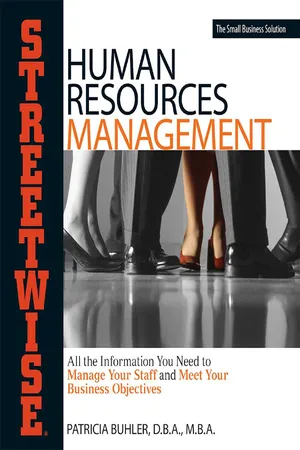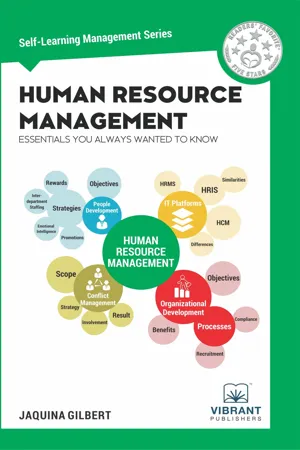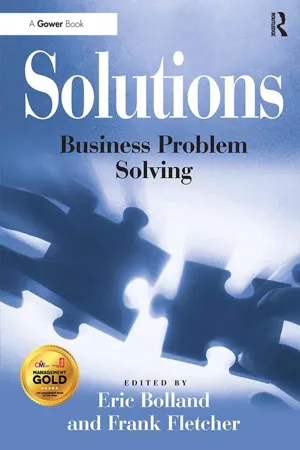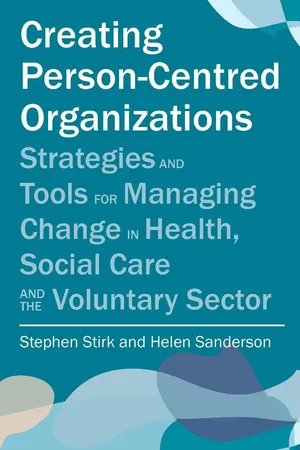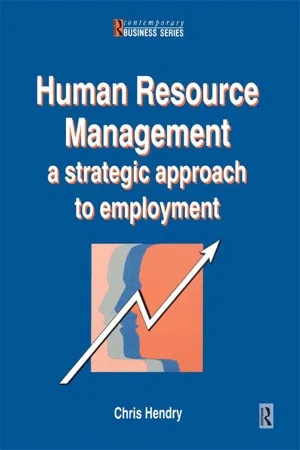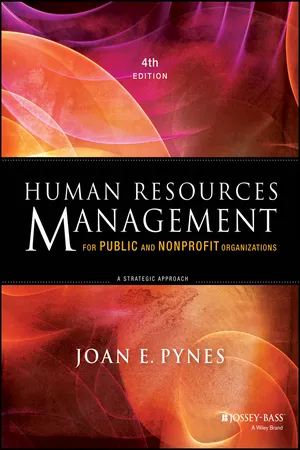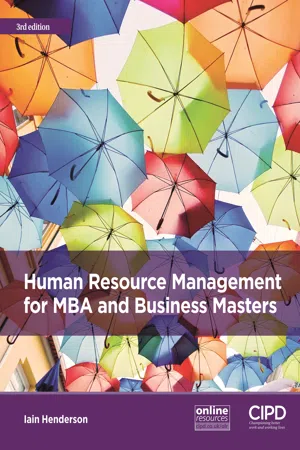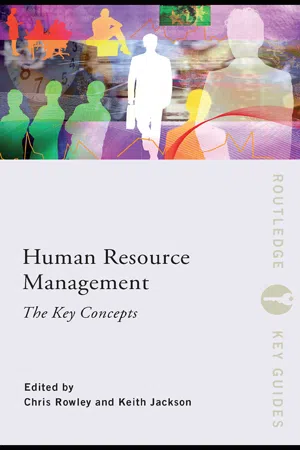Business
Human Resources
Human resources refers to the department within an organization that is responsible for managing the workforce. This includes activities such as recruitment, training, performance management, and employee relations. The primary goal of human resources is to ensure that the organization has the right people with the right skills in the right positions to achieve its objectives.
Written by Perlego with AI-assistance
Related key terms
10 Key excerpts on "Human Resources"
- eBook - ePub
Human Resources Management
All the Information You Need to Manage Your Staff and Meet Your Business Objectives
- Patricia Buhler(Author)
- 2002(Publication Date)
- Everything(Publisher)
Consider the possibility that companies in the future will have human resource support positions located in each business unit. These individuals will be responsible for learning the business of that unit and advising their managers about human resource responsibilities. The ultimate responsibility for the human resource functions, however, will lie with the managers and supervisors. The human resource individual will simply be acting in a support role, which will enable the human resource function to truly support the achievement of that business unit’s objectives.Human Resources are the people (including their knowledge, skills, and abilities) within an organization who perform the actual work of the organization. Their efforts enable the organization to meet its objectives. The intellectual capital of each organization has been a growing focus in our highly competitive world.Human Resources are the people (including their knowledge, skills, and abilities) within an organization who perform the actual work of the organization. What Are Human Resources?Human resource management (generally referred to as HRM) is the effective use of an organization’s Human Resources to improve its performance. This management is no small order; it takes great skill, ability, and practice.HRM is one of the greatest challenges facing businesses today. The challenge is not just faced by human resource professionals; it is the responsibility of all managers throughout an organization. Management is the practice of getting things done through others. Only by effectively managing the firm’s Human Resources will the goals and objectives be met.Although all companies have access to the same technology and the same information, it is the people within each organization who make the difference in organizational performance. That is, Human Resources provide the foundation for the organization’s competitive advantage. But the challenge remains: How can you get the most out of the work force and create a sustainable competitive advantage?TIP The evolution of the terminology from personnel to human resources communicates the role that people play as a crucial resource of an organization.Each unit within every organization is responsible for addressing this challenge. Although the specific solutions may vary from organization to organization or unit to unit, the basics remain the same. A clear understanding of the basics of human resource management enables every manager to help build the company’s competitive advantage through people. - Vibrant Publishers(Author)
- 2020(Publication Date)
- Vibrant Publishers(Publisher)
The operative functions are more widely suggested as various individuals have contributed to their idea of a comprehensive list. Most familiar, the operative functions are characterized as:▪ Recruitment or hiring▪ Job analysis and design▪ Performance appraisal▪ Training and development▪ Compensation▪ Wage and salary administration▪ Benefits administration▪ Employee health and welfare▪ Maintenance and retention▪ Labor and employee relations▪ Research▪ Legal compliance▪ Records managementFigure 1.3 Recruitment of Skilled EmployeesIt is ideal for maintaining an intelligent and skillful workforce by employing the best talent to complement the roles, the culture and the vision of the company. Human Resource Management is responsible for the intake of persons they perceive would be of a great addition and purpose to the company. Recruitment of otherwise unfit persons would mean a decline in the productivity and competitive prowess of the organization.Directing A company’s Human Resources or workers may, at some point,not know what or what not to do. Human Resource Management then attempts to set objectives and put the Human Resources on a course to success. Without that, productive activities might be approaching the wrong course.The Utility of Available ResourcesBoth human and nonHuman Resources are necessary to yield the best efficiency and progress for an organization. The idea of the establishment of Human Resource Management then bolsters the chances of being able to utilize what is available. This could involve apportioning duties to the available workforce/nonhuman resource to achieve a goal or maintain a relatively strong competitive advantage.Ensuring a Healthy Employer-Employee RelationshipHuman Resource Management ensures fluidity in the dealings between employers and employees. John Kennedy also said, “The human mind is our fundamental resource.”- eBook - ePub
Solutions
Business Problem Solving
- Frank Fletcher, Eric Bolland, Eric Bolland(Authors)
- 2016(Publication Date)
- Routledge(Publisher)
CHAPTER 7 Human Resource Management SAL MIRZA and CORINNE FARNETIThe phrase human resource management (HRM) brings about a diverse array of thoughts, emotions and reactions. For many, these can be negative. What have I done wrong? What new policy will I have to adopt? What data do I need to provide? Or even, what now? The human resource department historically has been viewed by employees as nothing more than an administrative bureaucracy that contributes little to the organization’s productivity. However, these impressions and the role of HRM have been shifting over the past several decades.Changes in the business environment, such as the adoption of the innovative workplace, the increasing diversity of the labor force, work-life balance issues and globalization have resulted in a shift away from traditional human resource management. The focus has moved from employee advocacy to a strategic partner. HRM concerns and concepts are integrated into the strategic plan of the organization. HRM is now primarily concerned with developing human resource practices that enhance a firm’s competitive advantage through its most valued asset, its people.The Human Resources (HR) function can provide significant support and advice to management. The attraction, development, and retention of high caliber people are a source of competitive advantage for your business, and are the joint responsibility of HR and management. HRM is no longer just the responsibility of the human resource department. CEOs, directors, department heads, middle managers and line managers are also increasingly concerned with these tasks. Managers now have increased accountability for their direct reports in the areas of hiring, development, succession planning and performance management.You as a manager will have to align your Human Resources through integration of decisions about your employees with decisions about specific organizational goals. This chapter offers HR professionals and organization managers processes, tools and resources to make informed HR decisions. - eBook - ePub
Creating Person-Centred Organisations
Strategies and Tools for Managing Change in Health, Social Care and the Voluntary Sector
- Stephen Stirk, Helen Sanderson(Authors)
- 2012(Publication Date)
- Jessica Kingsley Publishers(Publisher)
Chapter 8
Human Resource Management
I believe in the adage: ‘hire people smarter than you and get out of their way’.Howard Schultze, CEO of coffee chain Starbucks (1994)85Introduction
Our success in living our values and fulfilling our mission requires working closely together. Human Resources (HR) is about bringing the best out of the organisation’s most valued assets – the people who work there – and ensuring that their individual and collective contributions come together to achieve the mission.86 This combination of tools and techniques also goes under the names of personnel management, people management or people development, but essentially makes up all the ways that we have of dealing with the relationship between an organisation and the people who work for it.One simple definition is that human resource management is the process of matching individual staff and their contributions to the people supported and the organisation. The person-centred thinking Matching tool has a powerful contribution to make here. Getting the right staff to support people, well matched in relation to the support the person needs, their personality characteristics and ideally shared interests, is key to great human resource management.This chapter demonstrates how an integrated approach using person-centred practices with established Human Resources approaches can ensure that the talents and commitment of staff make a difference to the people supported.What does human resource management mean in a person-centred organisation?
The soft stuff is always harder than the hard stuff. (Roger Enrico, Vice Chairman of PepsiCo, referring to areas such as HRM as opposed to quantitative factors in Fortune , 27 November 1995)87It depends on what you define as hard and soft, but we would tend to agree that dealing with the myriad of diverse people we come into contact with is much harder than measuring widgets, and just as hard to know when you are actually getting it right. Too often we stifle talent and creativity, or even just contribution, by being too prescriptive about what we do and how we do it. When we talk about Human Resources management (HRM) in this chapter, we mean both what first-line and other managers do, as well as what an HR team may be responsible for. In keeping with the value of decision making happening as close to the person supported as possible, most of the recruiting process and certainly the selection decision for new staff would take place at an individual level – with the person and the manager of their service, not done by a central HR team. The HR team’s role here is in establishing a flexible, person-centred framework and processes that reflect the values of the organisation, and in taking the administrative and transactional burden away from managers so that they can focus on the quality of the selection decision. - eBook - ePub
- Chris Hendry(Author)
- 2012(Publication Date)
- Routledge(Publisher)
1 Human resource management: an overview
DOI: 10.4324/9780080517872-1Introduction
Human resource management (HRM) has gained rapid and widespread acceptance as a new term for managing employment. It remains, however, an ambiguous concept. People question whether it is any different from traditional personnel management, nor is it altogether clear what it consists of in practice.This chapter sets out the background of ideas on which HRM is based. Three common interpretations are identified. HRM is then compared with personnel management, identifying the special shortcomings of personnel management and those it shares with HRM.The chapter concludes by setting out the approach adopted in this book. This combines a view of organizations as employment systems set against the requirement to manage organizations in accordance with current business strategy.What do we mean by HRM?
Our starting point is that HRM has different connotations for different people and does not yet constitute a unified theory. We are all familiar with such statements as ‘our Human Resources are our most important asset’. In some cases, acceptance of the principles of HRM goes no further than this. Others emphasize that it is about matching employment practices to an organization's strategy. A corollary of this is that, taken as a whole, employment practices should combine together to reinforce one another. Part of this is that employment decisions should not be conceived in isolation, but ideally should be integrated through mechanisms such as personnel planning. At the same time, reward systems, the way promotions are made, who gets trained and why, all have effects on motivation and say something about what kind of organization it is and what behaviours it wants to promote. HRM is about making sure such personnel practices convey a consistent message.A third connotation is to present HRM as having a distinctive philosophy underpinning it, not just any set of values. This philosophy emphasizes securing employee commitment and motivation in organizations characterized by high-trust relations, with scope for employees to exercise influence. Management style and organizational culture then become an important focus for action in their own right. It is not enough that employment practices cohere, nor even that they should express the values of the organization. These values are of a particular kind. - eBook - ePub
Human Resources Management for Public and Nonprofit Organizations
A Strategic Approach
- Joan E. Pynes(Author)
- 2013(Publication Date)
- Jossey-Bass(Publisher)
Retoooling HR (2010), John Boudreau suggests that HRM use the logic and rigor of business frameworks to improve how Human Resources departments analyze, report, and optimize Human Resources. Using techniques from finance, marketing, and operations management, Human Resources practitioners can build on the decisions that organization leaders have made. For example, HRM departments could use concepts such as return on improved performance and key performance indicators to understand how workforce performance connects to business outcomes the way an engineer would convert process or component performance to improve product design and manufacturing. Other strategies to enhance performance include using portfolio analysis to balance planning for employee skills and talents for several future scenarios according to their likelihood and risk of occurring; using inventory management techniques to identify holding and shortage costs by planning for shortages or surpluses in necessary workforce skills; or using logistics management to identify the risk and return of succession planning by balancing the costs, benefits, and timing for various career paths. Using various techniques, organizations should invest in performance management, work analysis, and competency systems where they make the greatest impact.Human Resources Information Systems and Electronic Human Resources Management
The HRM function is responsible for attracting, developing, and maintaining the agency’s workforce. Human Resources identifies potential employees, maintains complete records on existing employees, and creates programs to develop employees’ talents and skills.Strategic-level Human Resources information systems identify the personnel requirements—such as the skills, educational level, types of positions, number of positions, and cost—for meeting the agency’s strategic plans. At the management level, an HRIS helps managers monitor and analyze the recruitment, allocation, and compensation of employees. Human Resources knowledge systems support analysis activities related to job design, training, and the modeling of employee career paths and reporting relationships. Human Resources operational systems track the recruitment and placement of the agency’s employees (see figure 2.1 - Iain Henderson(Author)
- 2017(Publication Date)
- CIPD - Kogan Page(Publisher)
et al 2007). This means something more than just ensuring compliance with legal protection for employees with respect to health and safety at work and against discrimination in employment.1.12 SUMMING UP
In today’s and tomorrow’s world, sustainable competitive advantage can only come from the skills, experience, creativity, imagination and brainpower of people. In the modern economy it is relatively easy to raise capital to fund a bright idea, but managing the Human Resources of an organisation to turn that idea into a business and achieve sustainable competitive advantage – how to create and build the next Google or Facebook or Apple – is the single most important management challenge in the twenty-first century.HRM is now the dominant paradigm in people management. It seeks commitment from employees rather than compliance; it tends to be unitarist rather than pluralistic in its approach to employee relations; and it places great emphasis on taking a strategic approach to Human Resources.In this chapter we have explored the nature of HRM and how it evolved and have looked at some of the key contemporary themes in the management of people in modern organisations. These themes are examined in more detail in later chapters.EXPLORE FURTHER
Armstrong, M. (2014) Armstrong’s Handbook of Human Resource Management Practice. 13th edition. London: Kogan Page.- Chapter 1 , ‘The essence of human resource management’; and Chapter 2 , ‘Strategic HRM’.
- These chapters provide brief overviews of their topics, useful for quick reference and starting exam revision.
Boxall, P. and Purcell, J. (2006) Strategy and Human Resource Management. Basingstoke: Palgrave Macmillan.- Chapter 1 , ‘Human resource management and business performance’ – this is a scholarly introduction to HRM which makes explicit linkage to business performance.
Boxall, P., Purcell, J. and Wright, P. (eds) (2007) The Oxford Handbook of Human Resource Management- eBook - ePub
- Stephen Taylor, Carol Woodhams, Stephen Taylor, Carol Woodhams(Authors)
- 2016(Publication Date)
- CIPD - Kogan Page(Publisher)
Thirdly, it is important to appreciate that increased competitive intensity is also having a profound effect on the way the HR function organises itself and approaches its objectives. Like all management functions, HR has to organise its own activities so as to be as efficient as possible. In recent years this has led to the adoption in many organisations of innovative approaches which involve HR professionals specialising rather than taking a traditional generalist role.Business partners work closely with line managers on day-to-day case work, while others manage HR administration out of shared-service centres. They are then supported by expert trainers, reward specialists, employment lawyers and recruiters, many of whom are employed as sub-contractors. Another major change that the HR function itself is having to get used to is the need continually and effectively to justify its own existence. This can no longer be taken for granted in a highly competitive business environment. The function is thus increasingly obliged not just to add value, but also to demonstrate that it does so – and in raw financial terms too.3.2.3 KEY CONTEMPORARY DEVELOPMENTS IN LABOUR MARKETS
The term ‘labour market’ refers to the market for staff and their skills that employers compete in so as to ensure that they can employ the best people in the jobs they have available. Like all markets, labour markets operate according to the rules of supply and demand. Ultimately this means that employers who can offer the best terms and conditions, the best chance of long-term job security, the best career development opportunities – or all three – give themselves the best opportunity of recruiting and retaining the strongest performers. And it is not just employers that compete in labour markets; would-be employees do too, as do existing employees vying with one another for promotion.There are many contemporary developments in labour markets which are having an impact on HR practice. We only have space here briefly to summarise some of the most striking and significant of these: increasing cultural diversity, increasing regulation and increasing inequality in UK labour markets. - eBook - ePub
- Chris Rowley, Keith Jackson(Authors)
- 2010(Publication Date)
- Routledge(Publisher)
Whether an agency is dealing with recruitment or this is being carried out by HRM staff an advertisement or briefing document must be drafted which contains sufficient details to attract suitable candidates (cf. People Management, 2007). These details will include a job title and brief description of the duties and responsibilities, brief information on the likely attributes of the applicants, taken from the candidate specification discussed above, the salary range or at least an indication of the likely pay and benefits, the name of the organisation (this is sometimes omitted especially if there is a need to avoid alerting competitors to business plans), the location and deadline. In an advertisement there will also be details of how the application is to be made – by completing a paper or online form or by submitting a curriculum vitae (CV) with a cover letter explaining the strengths the candidate has in relation to the position.Care has to be taken in advertising and briefing agents to ensure that particular groups are not disadvantaged on the basis of their background or beliefs. In the UK employment legislation and possible civil litigation means that if recruitment is mishandled unsuccessful candidates might claim discrimination and bring a claim for damages against the potential employer.WHSee also: best practice ; discrimination ; diversity management ; human resource planning ; international HRM ; job planning ; labour markets ; outsourcing ; selection ; strategic HRMSuggested further reading
Barber (1998): A detailed discussion balancing employer (organisational) and employee perspectives on recruitment. Incomes Data Services (2006): The London-based Incomes Data Services (IDS) provides regular updates on recruitment trends and statistics.Taylor (2002): A standard work in the field that connects with regular updates about recruitment policy and practice generated by the UK-based CIPD, a network of HRM professionals (www.cipd.co.uk ).RESOURCING
The field of HRM is often taken to comprise four major areas: employee resourcing, employee rewards, employee development and employment relations (see the introduction to this book). The key initial area is employee resourcing which can be taken as how organisations operationalise and staff their business strategies. This in turn concerns the utilisation of practices such as human resource planning (HRP), recruitment and selection (see these concepts in the relevant places in this collection). For some commentators the concept is even wider and also includes such areas as induction , absence, redundancy and retirement. This situation can be seen in Figure 7 - eBook - ePub
Working with External Quality Standards and Awards
The Strategic Implications for Human Resource and Quality Management
- Angela Mulvie(Author)
- 2018(Publication Date)
- Routledge(Publisher)
Chapter 7 ).HRM, HRD and the development of strategy
Priem and Butler (2001) consider that much of the strategy literature focuses on external, industry-based competitive issues as key drivers (Porter, 2004). As we see in Chapter 3 , when determining organizational strategy an initial analysis of existing parameters and constraints will be undertaken, and resources, competences and strategic capability will be considered, as well as stakeholder expectations and organizational purposes. Part of the early planning of strategy implementation will be the evaluation of strategic options using certain key criterion such as suitability, acceptability and feasibility (Johnson et al., 2017). Rumelt (1998) suggests consistency, consonance and advantage can also be used as measures of the effectiveness, as part of planning, review and control activities. The various activities which underpin the competitive advantage of the organization, e.g. Porter’s value chain can themselves be analyzed to create an understanding of how the management of such linkages will lead to competitive advantage for the organization. However, this perspective fails to recognize the value of resources, including HR, as important antecedents to products and a firm’s performance.Alignment of business strategies with those for people management (HRM) and people development (HRD) is difficult to achieve, in part because of the number of variables involved. As it develops, the HRD function as much as the HRM one has become more widely accepted as making a highly relevant contribution to organizational life. Mabey (2003) suggests that as HRD evolves from HRM and is applied in a practical way by individual managers who begin to see its corporate applications, we can begin to see differences in style and approach. Yet it is this practical application that represents the root of the problem of both definition and evaluation, of both HRM and HRD in their totality, and performance management as one of their dimensions. Arguably, both HRM and HRD have a role to play when external quality frameworks are being implemented as both staffing (HR) and training and development (human development) implications will need to be considered. What is missing from the literature, however, is consideration of where and how CI activities linked to working with external quality standards and awards might be integrated into strategic decisions.
Index pages curate the most relevant extracts from our library of academic textbooks. They’ve been created using an in-house natural language model (NLM), each adding context and meaning to key research topics.
